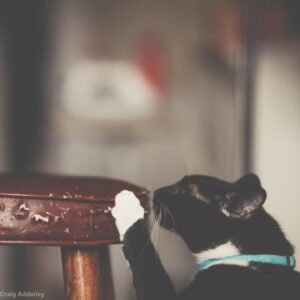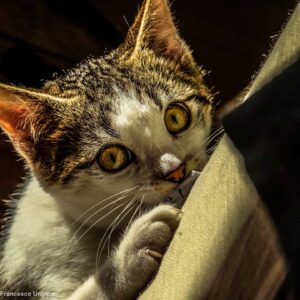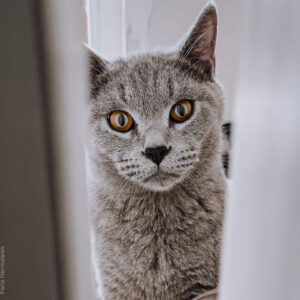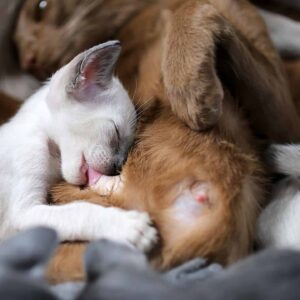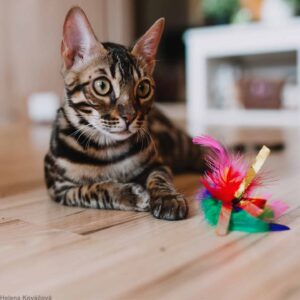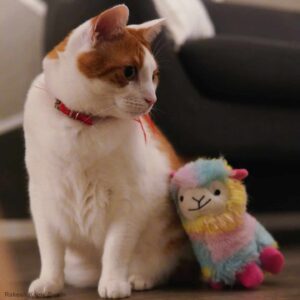Ron Hines DVM PhD
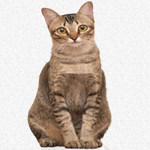
Over the years, I have seen many cat owners frustrated because their prize kitty, like the ones above, loved to sharpen its claws on their sofa, chew on the rug or munch on their potted plants. In a way, it is good to hear – those are almost always healthy, contented and happy cats. You consider it destructive behavior- but to your cat it is sheer pleasure. Your cat is not out to get even with you or make you suffer. It’s just being a cat. Here are some ways you might minimize the problem. In attempting to do so, keep in mind that you will never change a cat’s basic instincts and desires – one of the three things that create the problem. At best, you will channel is instincts elsewhere. What you can change are the other two factors, the cat’s environment and your reaction to its behavior.
How Might I Stop My Cat From Scratching On Things In My House?
It is natural for all cats to want to “sharpen” their claws on furniture around the house. They really are not attempting to sharpen their claws – they are sharp already. What they are doing is loosening and pealing off the horny material that naturally accumulates along the sides of the claw. Something they would naturally do by climbing trees and stumps or capturing their prey. In the process, they deposit their scent and the shredded bark and wood become sign posts that stake out the boundaries of their territory. Scratching also exercises the muscles of their front legs. Indoor cats rarely get enough exercise.
Cats enjoy scratching so much that it is a pity to declaw them just because the activity is destructive to your furnishings. Instead, provide them with carpet-covered habitats, posts or wooden posts with shreddable bark. Posts are easily constructed from discarded carpet, a four by four wood post and carpet tacks. Some cats prefer posts and boards covered with burlap or potato sacs; others prefer cork. Sometimes, a section of fireplace wood with the bark left on works well. Try to design the post or board so that it is at the same height and incline as the furniture the cat prefers and place it as close to the preferred furniture as possible. Once the cat is using the new post, move it gradually – over a week or two – to a better location. You can never have too many scratching posts. If you make them at home, I prefer you not use treated, (outdoor-intended) lumber. Most of that lumber has been dyed green.
You can show off your new posts to your cat by carrying the cat and setting it down in front of its new toy. Reward your cat with a treat and a stroke when the post gets used. You can guide the pet’s paws through the motion, hooking its claws on the pile until it gets the hang of it. Once a cat is using the new post, do not replace it even if it becomes raged. Cats can be perfidious and may not like the replacement. Try to make your furniture less attractive to your cat. Cats pick out scratching objects by feel and odor. If you can, close the door to rooms that hold the prized furniture. Covering furniture with cloth or a vinyl cover has never worked for me. You can also temporarily “mine” the area around the furniture with shallow pans of water, double-sided tape, Styrofoam cups piled into a pyramid, wind chimes, electric fans and mousetraps set upside down or with a magazine on top of them. A little ammonia or deodorizing spray on the fabric might also help your cat get the message.
I have never used plastic claw caps on my cats that are glued on, but I am told that they work well to prevent furniture damage. They need to be replaced every few months. But the same thing can be accomplished with a pair of toenail clippers and an emery board.
Chewing And Sucking On Objects:
I see this activity quite frequently in cats. Consider yourself blessed since sucking cats are usually very loving cats. Some speculate that these cats were weaned too early, but I do not know if there is really any evidence to support that theory. That sucking behavior seems particularly common in Siamese cats. Cats that like this activity will do it for hours on end. It is not an unhealthy activity and I tell owners to ignore it if they can. I do not think it is an obsessive/compulsive disorder because cats that exhibit the behavior are otherwise quite mellow and even-tempered. If you have a prized scarf or sweater, keep it out of reach of your cat.
Eating Strange Or Inappropriate Things:
Cats that chew and ingest fabric and other items are a different story. In this case, they often have bouts of indigestion and diarrhea as the material (hopefully) passes through their bodies. Thread, string, mats, blankets, potted plants (some toxic), Christmas tinsel, wicker and woven grass baskets and just about any other shreddable object are all eaten by some cats. I have even treated cats that ate loose change, If it happens once to your cat, rest assured it will happen again – unless you remove all these objects from its reach. Eventually, cats that eat odd objects get into trouble when the objects plug (obstruct) the movement of food through their stomach or intestines. Your veterinarian can coax some of these objects on through with petrolatum-based laxatives and enemas. Occasionally, they can be retrieved with endoscopes. But some must be surgically removed.
Stopping this activity in pets is very difficult. Cats never associate their indigestion with the object that was eaten. The best thing to do is place small items of interest to the cat out of reach and give your cat plenty of large, indestructible toys or household items to play with. Items made of short lengths (no longer than two inches) of cord or wool will not cause serious problems if they are eaten. Dog toys can be dipped in tuna gravy. I believe that boredom is the root cause of much of this activity. You might consider obtaining a second cat playmate for a solitary lonely cat. Purchasing a parakeet or lovebird and hanging its cage in the cat’s room also relieves the tedium of long days while you are away at work. Of course, that bird will have unique needs of its own – it’s a living, feeling animal, not a toy. Purchasing or making a “kitty condominium” with tubes, basking platforms, and hanging bells, tassels and ribbons will help occupy your cat’s spare time. One can also occupy the cat’s time by purchasing self-feeders for cats that require the cat to paw a lever to receive a treat. Some veterinarians prescribe mood-altering medications for these behavior. I do not believe these cats require or should receive mind-altering medications. I reserve those for true illnesses.
Many common houseplants contain poisonous chemicals. Luckily, almost all of these plants are bitter and avoided by cats. The exceptions are dieffenbachia or dumb cane, which is covered by small spicules which cause the cat to drool and foam. Considerably more dangerous are lilies. If your cat craves greens, keep a flat of sprouted alfalfa or lawn grass sprigs for the cat to graze on. Be sure the seeds were not chemically treated. Placing your houseplants on wrinkled aluminum foil will often keep cats away. Any of the strategies used to protect furniture will also work to protect plants. Instead of ammonia or odor neutralizer, you can sprinkle the plant’s pot with cayenne pepper sauce. The second most common environmental cause of sudden drooling and foaming in cats is when your feline friend catches a garden toad.
If chewing is due to anxiety and stress, a pheromone product called Feliway™ might be helpful. A 2017 study did not find Feliway-type products very helpful in combating stress in cats – at least not in cat shelter situations. (read here) However, it is certainly worth a try.
You are on the Vetspace animal health website
Visiting the products that you see displayed on this website help pay the cost of keeping these articles on the Internet.





